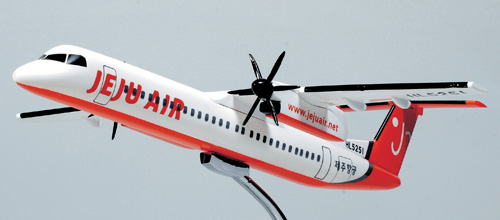How can budget airlines offer low fares?

Jeju Air’s Q400 accommodates a maximum of 78 passengers. Provided by Jeju Air
The number of low-priced, or budget, airlines is increasing constantly because of changing trends in commercial aviation.
Customers, the airlines found, value net savings more than comfort as the “open sky” policy began to spread. In South Korea, the interest among airline companies in low-cost airlines is increasing due to competition from high-speed trains.
Low-cost airlines operate independently, though some of them may be affiliates of large, mainstream airlines. For example, Singapore Airlines has Tiger Airways and Thai Airlines has Nok Air. American Eagle, of American Airlines, and Ted Airlines, of United Airlines, are other examples.
“The emergence of low-cost airlines was inevitable because they command about 35 percent of the entire aviation market,” said Glen Tilton, the president of United Airlines, who established Ted in 2004.
Ted Airlines differentiated itself from other low-priced airlines. For instance, consumers are able to earn and save frequent flyer miles from United Airlines and use the mother airline’s airport lounges, as well as check-in and luggage service for connecting flights between Ted Airlines and United Airlines. United considers Ted a successful venture.
However, several large carriers have abandoned similar ventures in budget airlines. Delta Airlines dropped Song Airlines last year after three years of operation because costs were running higher than expected.
There are currently only two budget airlines in Korea ― Jeju Air and Hansung Air ― but some groups have been showing interest in the low-cost airline business lately.
Korean Air announced recently that it would establish a budget airline. The strategy is to keep high-quality service for business travelers, and build up another airline with low prices for regular travellers.
Budget airlines can afford to be cheap by doing away with some services. For example, there are no assigned seats or in-flight meals. Korean Air’s image of being an upscale airline may therefore suffer if it uses the same name for its budget airline. Such a venture will mainly serve domestic routes and nearby places in Asia such as Japan, China and Southeast Asia. In Korea, Jeju Air has started operating with fares 30 percent cheaper than normal prices.
A budget airline may sell airline tickets at low prices, but its fares are not off-season ticket rates. These airlines reduce the costs in service in order to reduce the price of the tickets.
In 1971, Rollin King and Herb Kelleher started up Southwest Airlines in Texas. It was a typical low-cost airline. Currently, 60 million customers per year from 60 different cities fly Southwest.
Since the 1980s, Southwest has never had a deficit in its history. The number of its employees ballooned from an initial 195 to 26,000, without any record of layoffs or accidents. As Southwest sales reached $1 billion, the company has been listed as one of the best places to work in the United States. Crewmen in this airline work in T-shirts and shorts, reflecting the company’s business style.
Budget airlines have also been successful in Europe, such as Ryan Air in Ireland and easyJet in the United Kingdom.
Why are ticket prices cheap?
The key is a quick-returns policy. Decreasing prices due to reduction in operating costs makes the number of customers go up, which means more flights and more business from flyers.
In a Ryan Air campaign, 10 million seats were to be sold for 10 to 20 pounds ($20 to $40) during a four month period; of these, 3.5 million seats would be sold for 10 pounds. At the end of the campaign, its profits were more than 20 percent.
Budget airlines do not serve in-flight meals to lower costs. Water is free but beer is available for $3 and sandwiches for $5. This strategy is called the “no frills” policy. The word frills usually implies decorations or things that are appealing, but not absolutely necessary.
Moreover, ticket sales are done directly through telephone or the Internet.
Southwest Airlines customers are able to book seats a year in advance. Prices depend highly on the time of year and day of the week. There are three different fare classes, and a “first come, first board” policy. This saves more than 50 percent in management expenses.
Budget airlines can also save in airport costs. easyJet, which is based in London, England uses small airports in the suburbs. Even though it does not advertise, its flights are almost always full.
By Kim Chang-woo JoongAng Ilbo [wohn@joongang.co.kr]










with the Korea JoongAng Daily
To write comments, please log in to one of the accounts.
Standards Board Policy (0/250자)